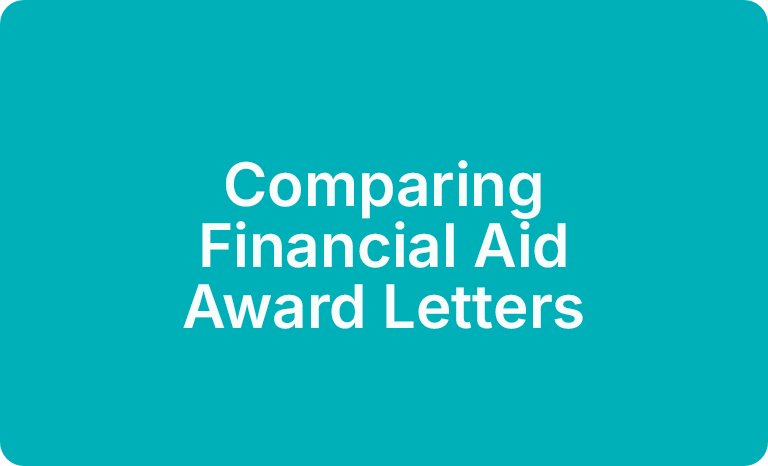Financial Aid 101 for College
This guide will help you understand the costs associated with college and explore your options to make it more affordable and accessible. Understanding the real cost of college, your financial aid options, and the potential debt you may incur are essential steps to making an informed decision.

What are the common costs?
The “cost of attendance” associated with attending college includes direct and indirect costs.

Direct costs are items that will appear on your college bills, such as:
Tuition and fees: The amount of money for instruction and other services.
Room and board: The cost of housing and meals, on-campus or off-campus.

Indirect costs will not appear on your bill. These are estimated costs associated with attending college and should be included in your budget, such as:
Books and supplies: Estimated cost of textbooks, software, materials, and other necessary supplies.
Transportation: The cost of traveling to and from the college or program. This can be commuter or long-distance travel.
Personal expenses: Costs such as clothing, toiletries, and other personal items.
Miscellaneous costs: Other potential costs such as health insurance, technology or equipment, and loan fees.

Sticker price vs. net price
The sticker price is the tuition cost listed online or published by the college. Since it does not include financial aid, it is not always the amount that students end up paying. The net price is the amount you will pay after subtracting financial aid that doesn’t need to be repaid, such as grants and scholarships. The net price varies depending on factors such as family income and financial need.
Hint: Use the net price calculator available on college websites to estimate the total amount you will pay in an academic year. Visit the U.S. Department of Education’s website to learn more.

How do most students pay for these costs?
Students pay for the cost of attendance using a combination of ways:
- Financial aid: Money that students use to help them pay for college.
- Personal savings: The personal savings of their caregiver and/or the student.
- 529 Plans: Tax-advantaged accounts to help parents, grandparents and others pay for higher education expenses. Contributions to these plans can grow tax-free, and withdrawals used for qualifying education expenses are also tax-free.

What is financial aid?
Financial aid is money you can use to help pay for college. The amount and type of financial aid you could receive largely depends on your financial need, which is the difference between the cost of college and the amount that you and your family can afford to pay. This need is determined by completing the FAFSA, Free Application for Federal Student Aid. Students receive most of their financial aid from federal, state and college aid. External scholarships are also highly sought after, but only about 7% of students receive them.
Free Application for Federal Student Aid (FAFSA)
The FAFSA is a form that each student, beginning senior year, must complete every year to be eligible to receive state and federal student financial aid to pay for college. Additionally, many colleges and institutions and private scholarship programs use FAFSA information to award their own grants, scholarships, and loans. Funding is often granted on a first-come, first-served basis, and it’s recommended to apply as early as possible. Learn more about the FAFSA and get free one-on-one support completing it through our partnership with Stand By Me.
Types of financial aid
There are two main types of financial aid: gift aid and self-help aid.
Gift aid
Money that does not have to be paid back and includes scholarships and grants.
Grants:
You can get grants from the federal government, your state, and your college. Fill out the FAFSA each year that you’re in school to be eligible for these awards.
Eligibility: Complete the FAFSA and have financial need.
Amount awarded: Varies based on your financial need and the cost of attendance at the college.
Repayment: Generally, grants do not have to be paid back, unless:
You withdrew early from the program for which the grant was given to you.
You received outside scholarships or grants that reduced your need for federal student aid.
You received a TEACH Grant, but you did not meet the requirements of your TEACH Grant service obligation.
Common grants Include:
Pell Grant:
Eligibility: Complete the FAFSA and have financial need Amount: Varies based on need, with a maximum award per year of $7,395 (amount may change annually)
Awarded by: Federal government
Outside scholarships: No, receiving outside scholarships does not reduce the amount of the award
Federal Supplemental Educational Opportunity Grants (FSEOG):
Eligibility: Complete the FAFSA and have significant financial need
Amount: Ranges from $100 to $4,000 per year
Awarded by: College
Outside scholarships: Yes, receiving outside scholarships can reduce the amount the award
Teacher Education Assistance for College and Higher Education (TEACH) Grants:
Eligibility: Complete the FAFSA, have financial need, and pursue an education degree
Amount: Up to $4,000 per year
Awarded by: Federal government
Repayment: To avoid repaying this grant, you must work in a high-need field or at a low-income school for at least four years within an eight-year period after graduation
Scholarships
These are awarded by the college or private organizations based on financial need, academic performance, extracurricular involvement, or other areas of excellence such as sports, arts, leadership, or community involvement. Many scholarships will you require to complete the FAFSA or prove financial need.
State scholarships:
Most states offer scholarships for their residents. In Delaware, these include:
State of Delaware Scholarships: Awarded for academic merit, financial need, and career focus
View >>
SEED+ Scholarship: Attend Delaware Technical Community College (DTCC) or the University of Delaware Associate in Art Program (AAP) tuition-free
View >>
Inspire Scholarship: Offers a 4-year tuition-free scholarship at Delaware State University
View >>
College scholarships:
Each college has scholarships they award to students based on academic or athletic merit, financial need, and specific majors. Some colleges post these on their financial aid webpages.
External scholarships:
These are sponsored by businesses, foundations, and other organizations. The application process, award amounts, and eligibility requirements vary widely. Although external scholarships are highly sought after, only about 7% of students receive them, with most funding coming from federal, state, and college aid.
Delaware Scholarship Compendium: Explore our Delaware Scholarship Compendium, which has over 300 scholarships for Delaware residents to help pay for college and trade/technical schools.
View >>
Hint: Create a standard scholarship essay to streamline the process of applying for multiple external scholarships.
Self-help aid
This refers to financial assistance that requires repayment or earning, typically through loans, work-study programs, or payment plans. Here’s an overview:
Student loans:
These are loans for students or their parents specifically for post-secondary education and must be paid back with interest. There are two options for student loans: federal and private. It is strongly recommended that federal loans be borrowed before taking out private loans.
Work-study:
A federal program that allows students with financial need to work part-time either on-campus or off-campus to help cover educational expenses. Work-study jobs are often designed to accommodate students’ academic schedules.
Payment plans:
These will allow you to spread your payments through the year instead of a couple of large payments. Some colleges charge a fee for these services, so you need to carefully review the college’s payment plan options.

Financial aid award letters
For federal and college financial aid (grants, scholarships, loans, work-study, etc.) you will receive one award package, also known as a financial award letter or offer, from each college that accepts you. View a sample award letter here. Typically, this package is available shortly after you receive your acceptance. It can be found on each college’s online applicant portal and is sometimes also mailed. Each college’s award letter will look different, but at a minimum include all of the following for one year of education:
Direct “billable” costs:
Exact costs for tuition, fees, room, and board. These are the charges that will appear on your college bill.
Indirect costs:
Estimated costs for which you need to budget, including books/supplies, transportation, and other education-related expenses.
Financial aid awarded:
This section details the amount of financial aid you will receive, including grants, scholarships, work-study, and student loans.
Net cost:
This is the total cost of attendance per year minus any grants and scholarships. This represents the amount you must pay out of pocket or cover with loans or other aid.
If you have any questions or don’t understand what’s in your aid offer, contact your school counselor or the financial aid office at the college. They are here to help!


When deciding which college to attend, it is essential to compare your financial aid award letters. Sometimes, you may find that a more expensive school gives you more gift aid, reducing your net price. Focus on the net cost after subtracting gift aid to determine how much you’ll need to pay out of pocket. You can use our “Compare Financial Aid Award Letters” organizer to compare your financial aid awards from different colleges.

You can use Tuition Fit’s “Fair Price,” a free tool, to see how your offer compares to thousands of verified financial aid awards offered to similar students at the same college.

You are not required to accept all of the financial aid offered to you. It is recommended that you accept financial aid in this order:
- Grants
- Scholarships
- Work-study
- Federal loans: Loan amounts in your award letter may be more than you need. Only take out what you actually need.
Keep in mind that you are not locked into attending a college by accepting a financial aid award package unless you apply early decision. You commit to attending when you pay your enrollment deposit. Learn more about “Decisions, What Happens After You Apply to College?”
How to appeal a financial aid award letter:
If your financial aid award letter is less than you hoped for, you have the option to appeal. You can use free tools like SwiftStudent to help you write a financial aid appeal letter.

Other financial aid resources 
Continue to grow your knowledge about financial aid by exploring the resources below:
What College Affordability Actually Means >
Read about What College Affordability Actually Means by the Urban Institute.
Federal Student Aid Estimator >
Estimates your eligibility for loans, grants, and work-study.
Best Financial Aid Websites >
NACAC’s list of trusted, up-to-date sources to help you and your family navigate financial aid.
StudentAid.gov >
The federal government’s financial aid website.
Financial Aid & Financial Literacy for First-Generation Students >
The Center for First-Generation Student Success’ financial aid resource guide.
Student Aid Tips for Unique Student Populations >
NASFAA’s tip sheets for tip sheets designed to help unique student populations (adult learners, undocumented students, military and veterans, wards of the court, foster youth, and single parents).
Admissions glossary terms >
Reference our admissions glossary terms to learn more about the language behind applying, acceptances, and postsecondary degrees and certificates.


The earlier you begin thinking about paying for college the better.
All students will need support from their caregivers to complete the financial aid process.
Getting financial aid takes commitment and time. Students and their caregivers should schedule time together to work through the process.
The most expensive colleges often have the most money to help the neediest students pay for college.
Applying to financial aid is free. Be wary of anyone that whose services cost money to help apply for financial aid.
